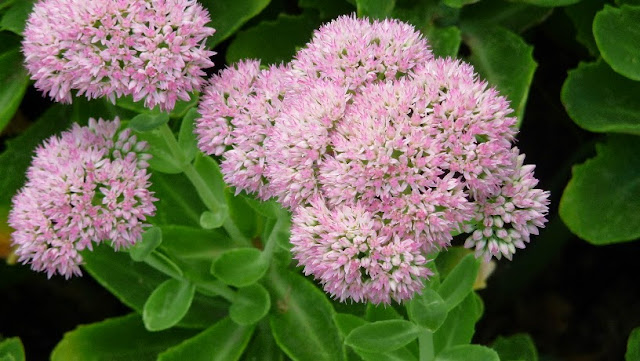Here is the same plant still looking handsome in April.
Sedum Spectabile
- The name Sedum Spectabile is still used commonly although botanically the Genus is now known as Hylotelephium Spectabile.
- The Crassulaceae family contains 300 species, most of which are low spreading succulents that vary enormously in foliage and form. Some of the larger autumn-flowering species are now classified under Hylotelephium and Rhodiola.
- Sedum Spectabile like all Sedums is drought tolerant and will grow in many soil types. Although it tolerates poor rocky and sandy soil, they grow very well in my clay based organically active soil. They don't like too much water but will benefit from a good drink when setting flowers.
- They are very easy to propagate and grow, requiring very little attention.
- They grow to about 600mm in my garden, and stay compact most of the year.
- The flowering stems begin to form clusters of pale green buds in early summer, and slowly grow looking very decorative until early autumn, when the delicate pink flowers emerge.
- The bees love them. They are a welcome source of food during a period when not too much else is in flower in my garden.
- These beautiful pink floral clusters gradually darken until they are a deep brown colour. Despite this they still hold their form and are handsome in the right setting.
- I don't deadhead the flowers, but when they get straggly, I cut then back to the larger leaves lower down the stem. The plant gradually dies back to the ground in the cooler months and re-emerges in spring forming small pre-leaf clusters on the ground which gradually develop to the full sized plant.
- I feed them with a light layer of good quality compost while still dormant, and spray them every month with aerated compost tea. I propagate them by root division, but you can get good results from cuttings and from seed.
- Binomial Name: Hylotelephium Spectabile.
- Family: Crassulaceae.
- Garden bed type: Drip line irrigated.
- Plant Spacings (centres): 500mm.
- Climate: Warm Temperate.
- Geography: Southern Hemisphere.
- Best in full sun but will tolerate partial shade.
- Minimise soil disturbances to maintain a natural soil structure.
- They can be propagated by root division in mid winter before new shoots start growing vigorously. Cut them with a spade into 2 or 4 pieces dependant on size.
- Remove the segments taking care to keep the roots and included soil together, and plant them into a prepared bed
- Clear a space for your new shrub in September and dispose of any organic waste in the compost.
- When replacing an old Sedum, choose a spot which hasn't grown them for at least 3 years.
- Apply a 60mm thick top dressing of home made compost and cover with fresh straw mulch.
- Leave for 4 weeks to boost worm and microbial activity.
- Move some of the mulch to one side and dig a hole twice as big as the new plant's root ball. Place the plant in the hole and back fill with soil. Water it in well with dilute seaweed extract.
- Water the plants every few days until they are established, and then allow the drip irrigation to take over.
- Prune them down to the ground in winter and apply a generous layer of homemade compost covered with straw mulch on top of the surrounding soil.
- Spray the plant's foliage with aerated compost tea every month at the same time as the edible plants are sprayed.
- My Sedum have been pest and disease free for many years, but can be effected by the following:-
- Caterpillars.
- When mixed with water, Bacillus thuringiensis becomes a potent (organically certified) killer of butterfly caterpillars. It is sprayed onto the plants leaves, and when ingested, kills them by releasing toxins into their gut.
- They stop feeding and die within a few days.
- I use aerated compost tea as a foliar spray on all my ornamental plants. I don't claim this is as effective as the bacillus, but after one year using this spray, I seem to have less pests of any kind on my plants.
- General:
- Regular foliar sprays of aerated compost tea boosts the natural defences of Sedum by colonising the leaf surfaces with beneficial microbes. These microbes defend the plant against airborne pests and diseases.
- Similarly, proper soil preparation including annual applications of home made compost boosts the community of beneficial microbes, which defend the plant's roots against pathogens.


No comments:
Post a Comment